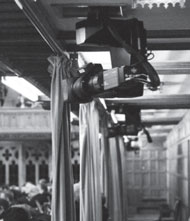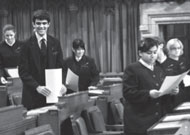Reaching Out and Engaging Citizens
OUTREACH PROFILE
Anniversary of Broadcasting House of Commons Proceedings
Canada's House of Commons has a proud tradition of engaging its citizens. In 1977, Canada became the first legislature in the world to televise its proceedings gavel-to-gavel. October 17, 2007, marked the 30th anniversary of the first broadcast of House of Commons proceedings.
Building on that accomplishment, this year the House of Commons was the proud recipient of the 2007 Government Technology (GTEC) gold medal in the Federal Award Category of Service Delivery to Citizens in recognition of its leadership, innovation and excellence for ParlVU-a Webcast service that gives Canadians access to live and on-demand video and audio streams of House of Commons and Committee events.

The remote-controlled cameras of the House of Commons seize democracy at work.
Photo: © House of Commons / Bernard Thibodeau
Outreach efforts are an important component of the work of the House of Commons. Canadian democracy is strengthened when citizens are given opportunities to learn more about how their Parliament works and how they can contribute. There are many avenues for Parliament to engage Canadians directly: sharing information; offering opportunities for citizens to provide input on bills during the legislative process; recruiting young Canadians to public service; and broadcasting proceedings to televisions and desktops across Canada and around the world.
Presenting Petitions
Members can present petitions on behalf of their constituents or other Canadians, to address issues of public interest or to ask Parliament to take action. Under the rules of the House of Commons, the government must table a response to each petition.
In 2007-2008, there were 927 petitions presented in the House-of which 452 were in the 39th Parliament's First Session (during sittings from April 16 to June 20, 2007), and 475 were in the Second Session (during sittings from October 16, 2007 to March 31, 2008).
Tuning in to Parliament
The hard work of all the Members of the House of Commons is broadcast to Canadians and the world through both online Webcasts and television broadcasts.
ParlVU-the House of Commons' Webcast service-carries live proceedings of the Commons, televised committee meetings and live audio of all other House of Commons committee meetings that are open to the public.
In addition, approximately one million Canadians tune in each week to the Cable Public Affairs Channel (CPAC), which provides television broadcasts of House and committee proceedings as well as political and public affairs programming.
Up-to-date news and information on parliamentary affairs is also available online at the Parliament of Canada Web site (www.parl.gc.ca). Visitors can quickly locate information on Members' activities, bills under consideration, committee activities and guided tours.
In 2007-2008, there were close to 7.6 million visits to the Parliament of Canada site.
Closed Captioning
OUTREACH PROFILE
Page Program Celebrates 30th Anniversary
In 2008, the House of Commons is marking the 30th anniversary of the establishment of its national Page Program. Open to Canadian students who have graduated from high school or CEGEP and are attending their first year of studies at one of the universities in the National Capital Region, the Program receives hundreds of applications each year. The 40 available positions are filled by a rigorous selection process, with successful candidates usually notified in early May.
The modern-day program first started in 1978 through the efforts of former Speaker James Jerome and other Members of Parliament. It gives young Canadians a unique vantage point to learn about the daily operations and procedures of the House of Commons. During their time with the Program, pages also share their passion for what they are learning by meeting with various youth groups to explain their work in the House of Commons.
Welcoming the first group of pages to the House on October 10, 1978, Speaker Jerome expressed his hope "that in future years, the entire country will benefit from having these citizens back in the country, better equipped through education and through their exposure here to a practical knowledge of the Canadian House of Commons."
More than 1,000 students from across Canada have participated in the Page Program since 1978.
Pages' tasks include setting up the MPs' desks before Question Period.
Photo: © House of Commons / Chris Diotte

The House of Commons, in partnership with the Translation Bureau of Public Works and Government Services Canada, now provides French closed captioning for Question Period, thereby making the work of Parliamentarians more accessible to all Canadians.
The House of Commons is among the world's first legislatures to use state-of-the-art voice recognition technology to perform remote live closed captioning of its proceedings. With the introduction of this new service, the estimated three million deaf or hard-of-hearing Canadians will be able to follow Question Period live through the use of either English or French closed captioning.
Opening Its Doors to All
Canadian and international visitors alike learn about the House of Commons and Parliament through tours and interpretive programs.
Tour Statistics for 2007-2008
Total Centre Block tours: 12,184 (372,000 visitors)
Total East Block tours: 1,281 (11,355 visitors)
Total school group visits to Centre Block: 1,721 (62,881 visitors)
Total visitors to Peace Tower and Memorial Chamber: 261,344



